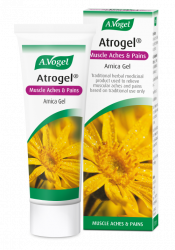What are antioxidants?
Antioxidants are substances that reduce and prevent damage caused by oxidation and the effects of free radicals – in other words they help to protect our cells from damage. They do this by removing waste products, or free radicals, in our cells before they can do us harm.
Free radicals are considered to be unstable compounds that damage cells, cause premature ageing and potentially contribute to certain diseases. Antioxidants occur naturally in plant-based foods such as vegetables, fruit, chocolate and tea however, they are also produced naturally in the body to help fend off viruses. They are released in the body from the foods we eat through our digestive process.
How can they help reduce joint pain?

Excessive free radical damage in the joint is the underlying cause of arthritis. Inflammation, although important in the healing process, can actually create more free radicals and cause more free radical damage which, in turn, results in more inflammation and so a vicious cycle can ensue. When it comes to preventing this free radical damage, antioxidants have something similar to superhero powers. Antioxidants literally destroy free radicals and thus prevent their pesky damage from taking place in our joints.
A study investigating the potential beneficial effects of antioxidants on patients with rheumatoid arthritis found that the number of swollen and painful joints were significantly reduced and general health improved. The study asked participants to consume 20g of an antioxidant rich spread daily for a period of 10 weeks. After the 10 weeks participants were then required to take part in a 4 week ‘wash-out’ period which confirmed a positive relationship of antioxidants helping to relieve symptoms of rheumatoid arthritis.1 However, further study is still needed to be able to determine how this works and the extent to which antioxidants can benefit our joints.
Those who have lower levels of vitamin C, beta-carotene, vitamin E and selenium, which are all important antioxidants, have a significantly higher risk of developing rheumatoid arthritis. Increasing levels of antioxidants can help to reduce cartilage loss, improve current symptoms of joint pain, swelling and inflammation as well as slow the degenerative process that can take place in our joints as we age.
Which antioxidants should you include more in your diet?

Arthritis symptoms could potentially be reduced by eating more foods rich in antioxidants because antioxidants help to reduce inflammation. Although it can be tempting to reach for a supplement (and sometimes we need to for a little top up) the best way to absorb the beneficial effects of antioxidants is through our food not through supplements. Why is this? Well, your body was designed to absorb antioxidants through food and not through tablet form. What’s more, tablets can sometimes be poorly absorbed by the body, particularly if we have a poor digestive system, or suffer from constipation or diarrhoea.
It’s also important to note that, while supplementing seems like it will solve all your problems, it is possible to consume too many antioxidants resulting in an array of other health problems later down the line. However, the good news is that it is extremely difficult to overdo it on antioxidants through your diet alone which is why many experts suggest sticking to dietary sources rather than supplementing.
• Glucosamine sulphate can help to increase your body’s production of cartilage as it contains a molecule called proteoglycans and helps your body to produce more collagen and proteoglycans
• Quercetin is thought to have powerful antioxidant properties that help to protect the cells against oxidative damage, particularly in high intensity exercise
• Curcumin, perhaps most well-known for its inclusion in turmeric, is thought to have antioxidant properties that work alongside anti-inflammatory effects
• Vitamin C, similar to quercetin, serves as an effective antioxidant that helps to remove the destructive nature of free radicals, it also plays an important role in the production of collagen.
So where can you find all of these extremely beneficial and helpful antioxidants? As I have already mentioned your diet is a great place to find them. Antioxidants are usually found in colourful fruit and veg such as strawberries, cherries, sweet peppers, beetroot and carrots and can also be found in spices such as turmeric. For more tasty food sources, antioxidant-rich recipes and information on the benefits of antioxidants check out this blog!
Herbs for joint pain?
 We’ve taken a thorough look at the benefits of antioxidants for joint pain but what herbs could help? There are a number of herbs that are beneficial for inflammation, some of which can easily be found in your kitchen. However, others such as the illusive Devil’s Claw is harder to find as it can only be found in the wild. In fact, to make our own Devil’s Claw tincture we trekked all the way to South Africa to organically cultivate and utilise this special herb. Traditionally, Devil’s Claw was used to relieve muscle and joint pains, rheumatic pain and backache.
We’ve taken a thorough look at the benefits of antioxidants for joint pain but what herbs could help? There are a number of herbs that are beneficial for inflammation, some of which can easily be found in your kitchen. However, others such as the illusive Devil’s Claw is harder to find as it can only be found in the wild. In fact, to make our own Devil’s Claw tincture we trekked all the way to South Africa to organically cultivate and utilise this special herb. Traditionally, Devil’s Claw was used to relieve muscle and joint pains, rheumatic pain and backache.








